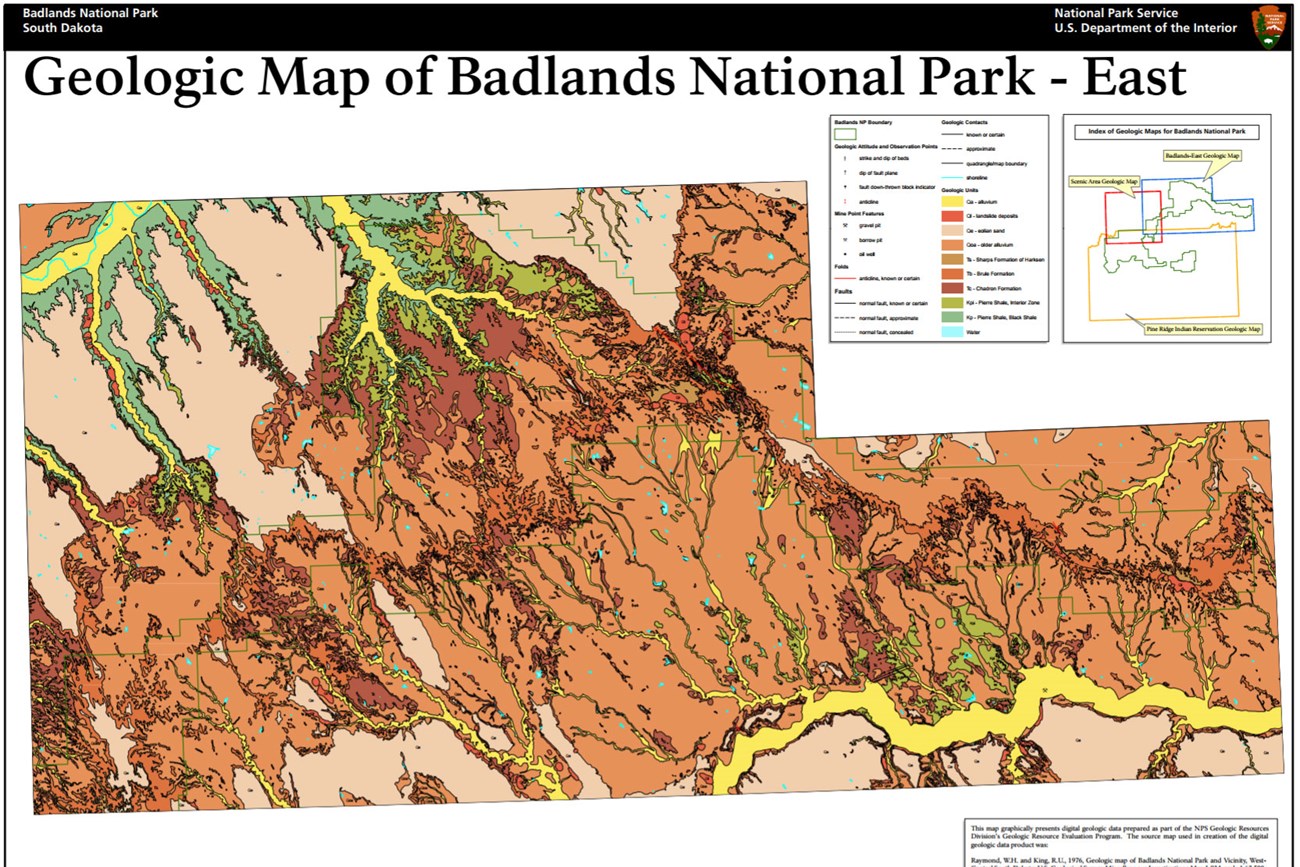Part of a series of articles titled Badlands Geology and Paleontology.
Article
NPS Geodiversity Atlas—Badlands National Park, South Dakota
Geodiversity refers to the full variety of natural geologic (rocks, minerals, sediments, fossils, landforms, and physical processes) and soil resources and processes that occur in the park. A product of the Geologic Resources Inventory, the NPS Geodiversity Atlas delivers information in support of education, Geoconservation, and integrated management of living (biotic) and non-living (abiotic) components of the ecosystem.

Geologic Features and Processes
Badlands National Park encompasses 242,756 acres in southwestern South Dakota and is home to striking erosional formations and the world’s richest collection of Oligocene- age vertebrate fossils. More than 250 vertebrate species, including both herbivores and carnivores, are represented in the park. Fossil beds in the Eocene and Oligocene formations of the White River Group allow reconstruction of the evolution of these mammal species and their habitat.
Paleontological resources were a major reason for establishing Badlands as a National Monument in 1939, for adding acreage in 1976, and for elevating the monument to National Park status in 1978. The Badlands strata record approximately 75 million years of Earth history. Past marine, near-shore, and terrestrial environments are all reflected in the sedimentary rocks exposed in the park.
Today’s landscape is dramatically different from the forests and savannas that covered the area in the Oligocene. Vegetation is sparse and erosion has carved the region into distinctive spires, pinnacles, hoodoos, monuments, buttes, and mesas that are known collectively as the White River Badlands. Badland topography was first recognized and described in South Dakota and the White River Badlands are the type locality for other areas that display similar intricately eroded topography.
The same weathering, mass wasting, and erosion processes that formed the landscapes in the past continue to create the distinctive badlands topography and landforms and expose the fossils that are visible today.
Paleontological Resources
Badlands National Park contains some of the most species-diverse Oligocene fossil beds in the world, contributing greatly to the science of vertebrate paleontology. All sizes of animals, from rodents to the elephant-size Titanotheres, lived on the floodplains that covered the Badlands region during the Oligocene. Golden moles, hedgehogs, and shrews ate Oligocene insects. Recent research on the Oligocene camelid, Poebrotherium wilsoni, has shed light on the dietary habits of these camelids as well as Oligocene climate (Wall and Hauptman 2001).
Fossils from the Oligocene strata of the White River Badlands have nearly twice as many mammalian families than are known today for all of North America (Weedon 1990). More than 50 species of herbivores and 14 species of carnivores have been discovered in the Eocene and Oligocene White River Group, primarily in the Oligocene Brule Formation (Kiver and Harris 1999).
All NPS fossil resources are protected under the Paleontological Resources Preservation Act of 2009 (Public Law 111-11, Title VI, Subtitle D; 16 U.S.C. §§ 470aaa - 470aaa-11).
Regional Geology
Badlands is a part of the Great Plains Physiographic Province and shares its geologic history and some characteristic geologic formations with a region that extends well beyond park boundaries.
- Scoping summaries are records of scoping meetings where NPS staff and local geologists determined the park’s geologic mapping plan and what content should be included in the report.
- Digital geologic maps include files for viewing in GIS software, a guide to using the data, and a document with ancillary map information. Newer products also include data viewable in Google Earth and online map services.
- Reports use the maps to discuss the park’s setting and significance, notable geologic features and processes, geologic resource management issues, and geologic history.
- Posters are a static view of the GIS data in PDF format. Newer posters include aerial imagery or shaded relief and other park information. They are also included with the reports.
- Projects list basic information about the program and all products available for a park.
Source: NPS DataStore Saved Search 2713. To search for additional information, visit the NPS DataStore.
A NPS Soil Resources Inventory project has been completed for Badlands National Park and can be found on the NPS Data Store.
Source: NPS DataStore Saved Search 2780. To search for additional information, visit the NPS DataStore.

Related Links
Related Articles
Badlands National Park
National Park Service Geodiversity Atlas
The servicewide Geodiversity Atlas provides information on geoheritage and geodiversity resources and values within the National Park System. This information supports science-based geoconservation and interpretation in the NPS, as well as STEM education in schools, museums, and field camps. The NPS Geologic Resources Division and many parks work with National and International geoconservation communities to ensure that NPS abiotic resources are managed using the highest standards and best practices available.Last updated: June 17, 2024

